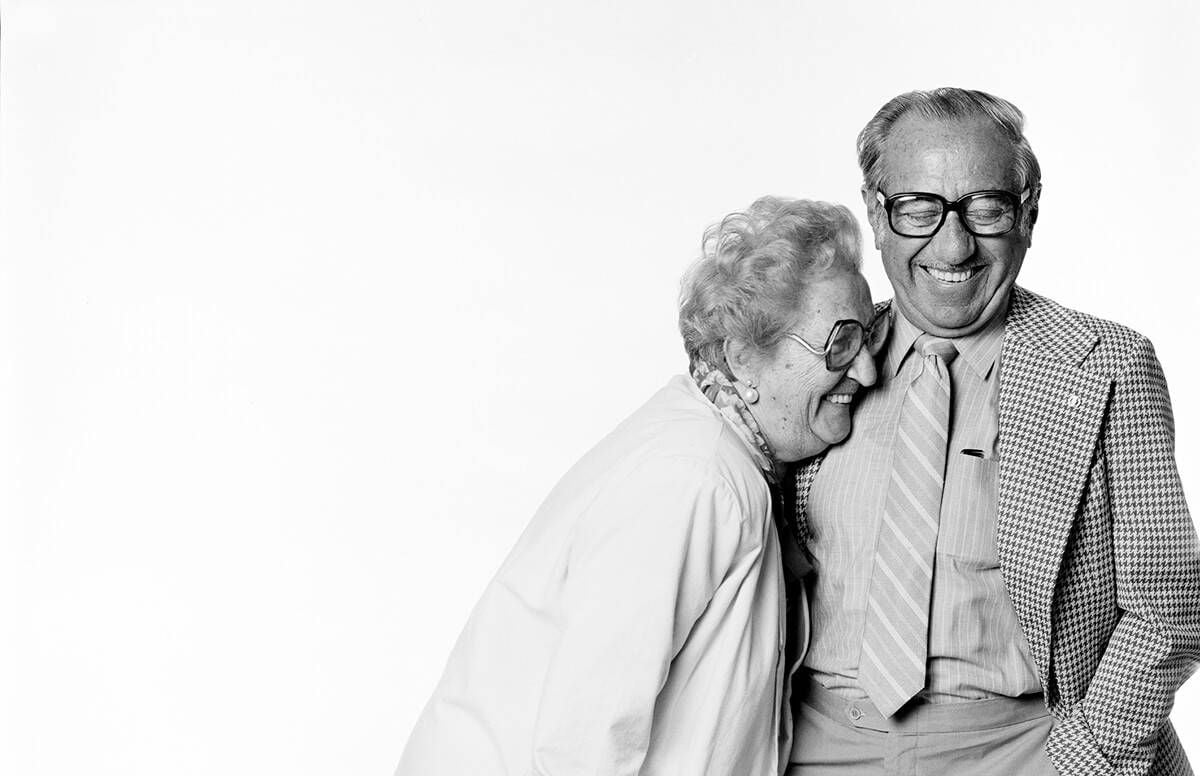How to Take Great Family Photos This Holiday Season
Tips from a pro photographer on getting pictures you’ll treasure
You may not think you have a lot in common with renowned photographer Barbara Bordnick when you’re trying to get family photos this holiday season. Bordnick’s work has been commissioned by Vogue, Harper’s Bazaar and Vanity Fair, after all. She’s shot portraits of many famous celebrities — Angela Lansbury, Marcel Marceau and Jennifer Garner, among them. Yet she was cowed at the prospect of taking a portrait of her parents.

“My father was very intimidating — charming, but intimidating,” she says.
So Bordnick enlisted the help of her mother, who knew just what to do to lighten the mood: She goosed her husband, which resulted in a spontaneous expression of mirth. And a great photo (at right).
“Accidents are the professional’s best friend,” Bordnick says. The unexpected can add spontaneity and life to a photograph. But that doesn’t mean great photos happen by accident. Taking frame-worthy family portraits requires patience, planning and know-how. This is how Bordnick does it — and how you can, too, during the holidays:
1. Build rapport.
“When you are taking a photo, you are asking people to be where they want to be the least — in front of your lens,” she says. “People ask me how I get my subjects to relax. The answer is: How do I relax? By becoming interested in the person.”
This takes time. “Something meaningful has to happen between the subject and me,” Bordnick says. For instance, she once photographed lyricist Yip Harburg, who wrote them for the The Wizard of Oz, among other musicals. “My favorite portrait of Yip is of him singing Over the Rainbow,” she says.
2. Don’t pose people.
Forget about asking people to smile or stand in a certain way.
“Look, really look, at who you are photographing until you see them,” Bordnick says. “The best facial expressions come from being comfortable and natural, so watch what they naturally do and work with that.”
If your subject turns away from the camera, go with it. Try photographing him or her in profile.
Remember that not all portraits are of someone’s face. One of the most famous photos of Winston Churchill was shot from behind.
3. Plan your shot.
When you look through the lens, think of it as an empty canvas. What goes on that canvas is your decision. You choose what’s in the background and what you want to frame.
Ask yourself: Is that what you really want to see in the photograph? Could something be moved, added or subtracted? What does it look like if you turn the camera? Try taking landscape and portrait shots to see.
“I am always annoyed when people cut off a hand at the wrist,” Bordnick says. “Hands and eyes are often the most important things in a portrait."
4. Eliminate distractions.
“As much as possible, be alone with the person,” Bordnick says. You're the boss. “Get rid of anybody that’s bothering you,” Bordnick adds.
5. Go outside.
Natural light is the best light. Just make sure your subjects aren’t backlit or squinting into the sun.
6. Skip the flash.
Avoid using the flash on your smartphone or point-and-shoot camera. If you absolutely must, back up several feet, zoom in and then use the flash. Or tape a piece of tissue paper over the camera’s flash to soften the light. That will distribute the light more evenly to help avoid harsh shadows. You can also use white paper or a white sheet to “create” more light and direct light.
7. Hold the camera or phone steady.
A handheld camera can make it difficult to get a sharp shot. Get a gorilla pod or a table tripod to keep your camera still.
8. Get an assistant.
You can’t be everywhere at once, and it really helps to have someone to hold reflective paper or move something into or out of the frame. Use a family member or friend to fix someone’s hair, shift a light source or fetch something for you.
“Maintaining contact with your subject must remain constant without distractions and having an assistant assures that,” Bordnick says. Children can be wonderful assistants. It will keep them occupied and make them feel like an important part of the process.
9. Keep your subjects occupied.
Bordnick gives her models “business,” as it’s known in the theater. Give subjects something to do, such as lean against the wall or cuddle up in their favorite jacket. You could also photograph them in context for something they are famous for: woodworking, cooking, knitting or whatever it is they love doing.
10. Deal with eyeglasses.
Tilt glasses down by putting tape on top of people’s ears to remove the possibility of glare.
11. Print and share.
Bordnick doesn’t believe a photograph is finished until it’s printed. A good portrait is one of the best gifts you could give a family member, she says. “There’s no greater pleasure than giving a print to someone. It’s a very special gift,” says Bordnick.

